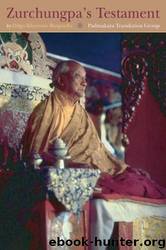Zurchungpa's Testament by Zurchung Sherab Trakpa & Dilgo Khyentse Rinpoche & Shechen Gyaltshab & Padmakara Translation Group

Author:Zurchung Sherab Trakpa & Dilgo Khyentse Rinpoche & Shechen Gyaltshab & Padmakara Translation Group
Language: eng
Format: azw3
Publisher: Snow Lion
Published: 2007-02-25T00:00:00+00:00
37
Meditation using the instructions on the method of "resting.""
Son, there are four instructions on the method.
To let go of the subject inside that apprehends the objects of the six consciousnesses-
We are talking here about the six sensory experiences-seeing forms, hearing sounds, smelling odors, tasting flavors, and feeling things.'Z° When we perceive an object, our reaction is to cling to what we perceive. For example when we see a form, the object, the eye and the consciousness interact and we think, "This is beautiful, I need it," or "That is ugly, I don't want it." We thus have an infinite number of such thoughts-of good and unpleasant tastes, fragrant and offensive smells, pleasant and unpleasant tactile sensations, and so on. All these lead to actions, and that is how the wheel of samsara is set in motion.
How should we let go of these clingings? By establishing the empty nature of the perceiving consciousness. Once we establish the empty nature of the mind, it is not that we cease to see objects, but rather that the sight of them no longer gives rise to clinging. Therefore, we no longer experience the attraction and aversion that lead to delusion. Free of these clingings, we should remain in meditative equipoise, which only one's self-awareness can experience. It is a state that is completely limpid and empty, like a vast open space, quite free from the stains of fixation. This is
The instruction on the state of mind devoid of all ordinary perception and thought, like a dry skull,
which has no eyes, ears, and tongue, and therefore has no ordinary perceptions.
Now for the actual instruction on the method of "resting," which is sixfold:
It is said that in meditation an object on which one makes an effort to focus is the prison of the view, so
(1) Leave things effortlessly in the expanse free from references.
In meditation, in which the yogi's concentration is like the flow of a river, the natural state unfolds. Through it we may have a glimpse of the absolute nature, and even though this glimpse is not full realization, we will be sure that it is not something we have fabricated and that this nature has been ours since the very beginning. Once you have recognized the absolute nature, remain in it without modifying it in any way:
Download
This site does not store any files on its server. We only index and link to content provided by other sites. Please contact the content providers to delete copyright contents if any and email us, we'll remove relevant links or contents immediately.
The Way of Zen by Alan W. Watts(6513)
Ego Is the Enemy by Ryan Holiday(5298)
The Art of Happiness by The Dalai Lama(4064)
The Book of Joy by Dalai Lama(3904)
Why Buddhism is True by Robert Wright(3405)
Spark Joy by Marie Kondo(3253)
Shift into Freedom by Loch Kelly(3139)
Happiness by Matthieu Ricard(2996)
A Monk's Guide to a Clean House and Mind by Shoukei Matsumoto(2870)
The Lost Art of Good Conversation by Sakyong Mipham(2578)
The Meaning of the Library by unknow(2508)
The Unfettered Mind: Writings from a Zen Master to a Master Swordsman by Takuan Soho(2249)
The Third Eye by T. Lobsang Rampa(2226)
Anthology by T J(2165)
Red Shambhala by Andrei Znamenski(2154)
The Diamond Cutter by Geshe Michael Roach(2022)
Thoughts Without A Thinker: Psychotherapy from a Buddhist Perspective by Epstein Mark(1965)
Twilight of Idols and Anti-Christ by Friedrich Nietzsche(1853)
Advice Not Given by Mark Epstein(1839)
